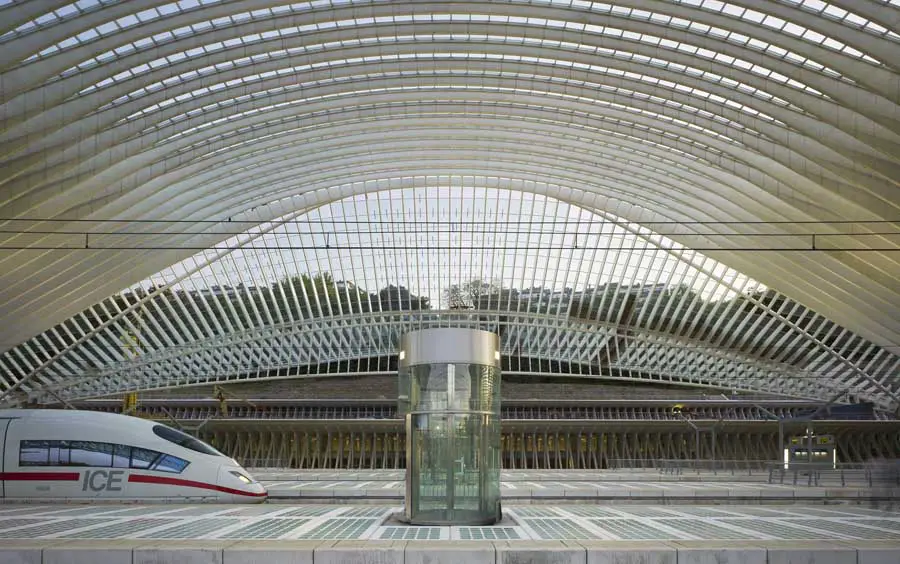Liege-Guillemins TGV Station Belgium, Belgian Calatrava Building Design
Liege-Guillemins TGV Station
Belgian Railway Development design by Santiago Calatrava architect / engineer
post updated 14 December 2021 ; 30 Sep 2009
Liège Guillemins TGV Station Design
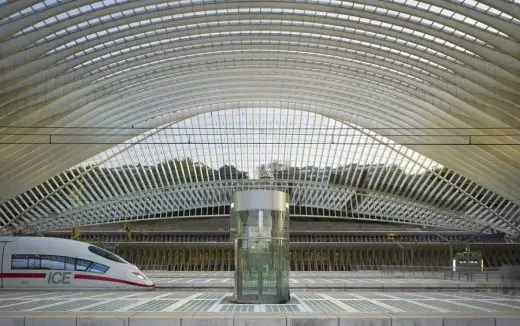
photos : www.palladium.de, Barbara Burg/Oliver Schuh
Liege-Guillemins TGV Railway Station
SANTIAGO CALATRAVA ARCHITECT STATEMENT
My intention from the outset has been to create a highly modern 21st century integrated Transportation facility that responds to its position at the foot of the Cointe Hills and from a belief that it must act as a catalyst for regeneration of the Guillemins quarter.
This portion of the City of Liege has sadly degraded due to being blocked in on all sides by railway tracks, a highway to Brussels and an expressway that cuts the link to the Meuse river banks. Its natural quality has been lost and replaced with a feeling of insecurity. The area directly in front of the Station is the site of asbestos ridden blocks and surface car parking erected in the 1960’s to house the “Citê Administrative de Finances” . These will give way to an urban plaza linking the Station back to the Meuse providing a focal point for renewal of the quarter as a whole.
The global orientation of the Station is prescribed by the railway lines but this provided a spur to generate a perpendicular axis along the new “Avenue de la Liberté” thrusting out toward the Meuse River. My sincere hope is that the new station and this new axis act together to create a project on an urban scale that the will lead to a regeneration of the entire quarter and act as an open invitation to the City of Liege to reconnect to the Meuse River.
My goal was to create a building that reflects the new stations potential significance as a high speed inter-urban link between Europe’s cities. The new rail links provide 20 minute travel times to Aachen, Cologne and Brussels while Frankfurt, Paris, London and the Southern portions of Europe are only a few hours away.
I decided that the station should not only be a transport hub but also a gateway to Liege itself. This idea provoked the development of the vaulted roof. I saw this as working in two distinct ways. When viewed from within the station (by passengers arriving by train) the vaulted roof and canopies form a balcony on a grand scale framing the City of Liege. For departing passengers arriving to the plaza the vision is inverted to frame the station itself and the Cointe hills beyond.
If this was to be achieved the station would have to be as transparent as possible. I imagined a building without facades with a soaring roof above offering protection from the elements (particularly the ever present rain of the Belgian Winter). This could maintain the views through and of the station. The vaulted shape was a natural development of this vision while the soft (perhaps feminine) undulating curve of the roof was selected to mimic the graceful rise and fall of the Cointe hills beyond.
I felt that there was no better way to celebrate the technological achievement of the TGV trains than to expose the working platforms and the dynamism of the moving ensemble of passengers and trains. With such levels of service to such varied destinations I was acutely aware of the danger that a new station could become a disorientating labyrinth of interconnections. Every station requires space for ticketing, waiting rooms, retail facilities etc. that must link directly with the trains. I chose to combine all these spaces in a zone below the platforms, “the Galleria”. To avoid this space having the feel of an underpass I filtered daylight through from above using glass block paving cast into the platforms above to convey the abundant natural light down through from the glazed roof. The use of natural daylight to create a feeling of wellbeing throughout all the spaces of the project is a recurring theme.
The glazed roof (tinted slightly to provide protection from the harshest rays) means that no additional artificial lighting is required during the day to the naturally ventilated space below. This ecological sensitivity is reflected in the choice of local materials, the specification of recycled or recyclable materials and ordering the replanting of the sections of the hills touched by the project. All thought through with a conscious notion to reduce the Carbon footprint of the project.
The station is arranged around a number of levels with the generous proportions of the Galleria space being mirrored in the wide walkways that provide the primary links across the station. These routes enable passengers to reach the covered parking facilities, as well as provide a quick and easy route for residents of the Cointe quarter to pass through the station and reach the platforms. I have found that the generous, well lit spaces that are created allow passengers to orientate themselves with great ease and that significant signage is no longer required.
Guillemins Station is a true multi-modal transport hub with Covered parking for 800 cars (with 1200 more spaces to follow) while the regions buses serve the front and rear of the station. A drop off zone is provided to allow taxis and private vehicles to enter and exit the station environs with a minimum of fuss. The overall dimensions of the Hall and the side wings was based on the practical considerations of the length of the trains serving the station with the more standard trains fitting in to the dimensions of the main hall. Oversized trains can be accommodated using the wing extensions as ancillary sections connecting back via travelators to the center.
The primary materials used to create the station are concrete (both precast and cast in situ) and steel (used for the 180m span ribbed shell-like roof). The station make as much use as possible of exposed structural finishes while “bluestone” (used historically throughout the region) has been selected for use in the floor paving, the cobbles of the plaza and feature elements such as the benches.
Perhaps the greatest, but unseen, achievement in constructing this station was that the station was erected in multiple small phases over an extended period of time allowing the station to remain open throughout. Indeed only short overnight closures were required to move 5-rib-wide segments of the roof over the working platforms section by section.
We have delivered a most Modern Station into the heart of a City creating a rightly prominent and vital link for Liege with the rest of Europe. I have no doubt that the quarter in which it sits and the City as a whole will benefit from its completion.
Liege-Guillemins TGV Railway Station Building information received 290909
Liege-Guillemins TGV Railway Station design : Santiago Calatrava
Liege Quillemins TGV Railway Station : main page on this major Belgian building
Location: Guillemins, liege, Belgium, western Europe
Architecture in Liège
Liège Architectural Designs – selection:
Belle-île, province of Liège, Wallonia
Architects: JDS Architects
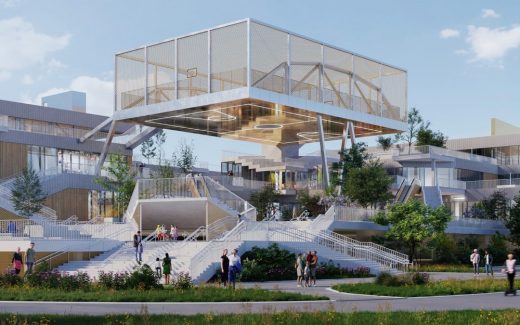
image courtesy of architects practice
Belle-île Shopping Center Building
Liège Ice Rink Arena
Design: L’Escaut – Weinand (Momentary Association)
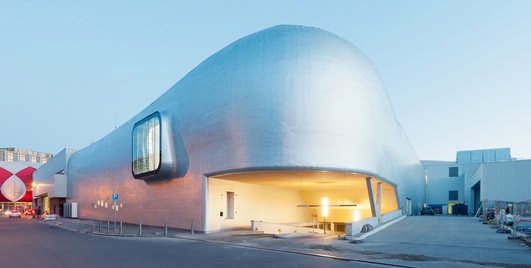
photo © Marc Detiffe
Ice Rink Liège
Architecture in Belgium
Belgian Architectural Designs – chronological list
Brussels Architectural Tours – city walks by e-architect
Belgian Buildings
The BrOnks Youth Theater, Brussels
Design: MDMA l Martine De Maeseneer Architects
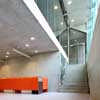
photograph from architects
The BrOnks Youth Theater Brussels
Accent Offices Roeselare, western Belgium
BURO II & ARCHI+I
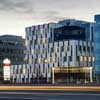
photo : Klaas Verdru
Accent Offices Roeselare
Santiago Calatrava Architecture
Comments / photos for the Liege-Guillemins TGV Station Belgium Architecture design by architect Santiago Calatrava page welcome

